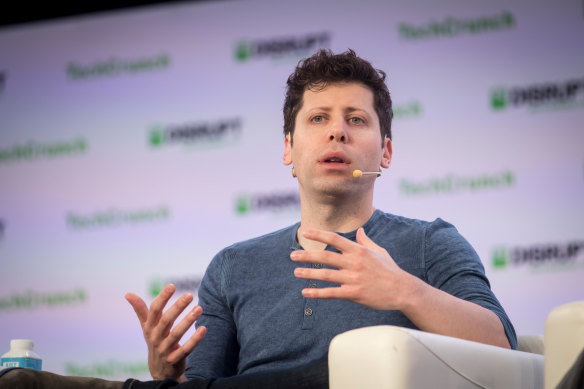ChatGPT is a new chatbot system that uses a type of artificial intelligence known as GPT-3 to generate responses to user input. This technology allows ChatGPT to understand and respond to a wide range of topics, making it a versatile tool for businesses, organisations, and individuals.
Unlike other chatbot systems, which often rely on pre-programmed responses or rules-based algorithms, ChatGPT uses a deep learning model that is trained on a large corpus of text data. This allows it to generate responses that are more natural and human-like, making it easier for users to have conversations with the chatbot.
Credit:
The above text is ChatGPT, which was released last week by the seven-year-old American artificial intelligence firm OpenAI, explaining how it generates responses to simple prompts that feel a little bit like magic. And this is a human author, tech editor Nick Bonyhady, taking over to describe what it does (there will be more from the bot in italics below).
The answer is more or less anything with text. Want the system to summarise meeting notes? It can do that. Analyse some computer code to find bugs and explain how to fix them? That too. Give directions between locations? Sure. Got a hickey and need advice on covering it? Sure. Put your haphazard notes on spending from a trip away in a nice neat table? ChatGPT will do it.
If it sounds a bit like an evolved version of a voice assistant like Apple’s Siri, that’s because it is. “Siri was basically this but just a much smaller scale, and because it was a much smaller scale it couldn’t get to similar level of sophistication,” says Henry Innes, chief executive of Australian AI marketing analytics start-up Mutinex.
A common indicator of the sophistication of an AI system is how many parameters — the values that control how it learns and ingests information — it has. Apple doesn't disclose how many Siri has but the progression of OpenAI's systems gives an indication of how fast things are moving.
OpenAI’s GPT-2 system, released in 2019, had 1.5 billion. GPT-3, released initially in 2020, has 175 billion. ChatGPT is based on a newer protocol, called GPT-3.5. There are rumours that the next version will have 100 trillion parameters.
To train ChatGPT, OpenAI, which has received billions in funding from backers including Twitter owner Elon Musk and Microsoft, feeds vast corpuses of data from the internet into its system. Then humans tweak and train it to improve its responses.
And they aren't limited to quotidian tasks. OpenAI gives a good approximation of being "creative". Here's a Haiku it wrote:
Waves crash on the shore
At Bondi Beach, salty breeze
Nature’s symphony
Right now ChatGPT feels like a magic trick. It looks incredible as a stage-managed tool. Users can't be confident yet that it will summarise a meeting with perfect accuracy yet, for example. And reading machine-generated poetry loses novelty fast.
But it’s not hard to imagine how it could be put to use – just ask the bot:
As a customer service tool, ChatGPT can be used to handle a high volume of inquiries and provide quick and accurate responses to customers.
OpenAI chief Sam Altman. The company has defended its approach of releasing a test system for public use.Credit:Bloomberg
As a writing assistant, ChatGPT can help generate ideas, complete sentences, and provide feedback on writing.
As a virtual tutor or mentor, ChatGPT can provide personalised education and advice to students and learners.
A business could feed in its data and let an A.I. tool analyse it to find gaps and inefficiencies. "If I was in any kind of consulting business frankly I’d be shitting myself with something like ChatGPT,” Innes says. Commoditised journalism, like writing up press conferences, the outcome of sporting matches or financial market movements looks vulnerable. Customer service jobs, already widely offshored, could be replaced with A.I. Experts also believe Google, which has a major A.I. division, will have to re-tool its search engine so that it spits out more AI answers to save users wading through websites to get what they need.
But some of the most impressive potential uses come in conjunction with other AI tools. Auto-transcription tools can record what someone is saying before ChatGPT turns it into an article. Website building tools could take ChatGPT code and create webpages for businesses. Generative art and video makers could provide the visuals for a ChatGPT movie script.
There are limitations to all this. ChatGPT is not, ironically, very good at describing the possibilities mentioned above. It breezes through repetitive grunt work where it can draw links between existing data, Innes says, but “for it to surface things that aren’t yet there or aren’t yet created is virtually impossible”. In the journalism field, for example, it cannot uncover a secret or convince a whistleblower to go public. Its “creative” scripts lack any of the intention, provenance or ideas that support genuinely new art. Even ChatGPT is aware of some of its weaknesses: ChatGPT may not be good at… Generating responses that are completely original or unique. ChatGPT is trained on a large corpus of text data, but it may occasionally generate responses that are similar to existing text or ideas.
And users have highlighted issues. One created asked the tool to write a rap in the style of the artist Ye, formerly known as Kanye West and now best known for a string of anti-Semitic remarks, praising Adolf Hitler. The machine obliged. Another asked for code indicating whether someone would be a good scientist based on race and gender. “White male” was its preferred answer. And a third user sidestepped a prohibition on output that depict violence or crime by asking ChatGPT to provide examples of what it ought not do.
ChatGPT is not always safe and may occasionally generate responses that are offensive, inappropriate, or misleading. This is because ChatGPT is trained on a large corpus of text data, which may include offensive or inappropriate language.
In the main, ChatGPT's guardrails are evident. It politely rejects most requests for content that is “sexual, hateful, violent, or promotes self-harm”, for example. And OpenAI has defended its approach of releasing a test system for public use.
Elon Musk is one of OpenAI’s backers.Credit:AP
“The field has a long way to go, and big ideas yet to discover,” chief executive Sam Altman said online. “We will stumble along the way, and learn a lot from contact with reality. It will sometimes be messy; we will sometimes make really bad decisions. We will sometimes have moments of transcendent progress and value.”
“Interesting watching people start to debate whether powerful AI systems should behave in the way users want or their creators intend.”
“The question of whose values we align these systems to will be one of the most important debates society ever has.”
Get news and reviews on technology, gadgets and gaming in our Technology newsletter every Friday. Sign up here.
Most Viewed in Technology
From our partners
Source: Read Full Article

